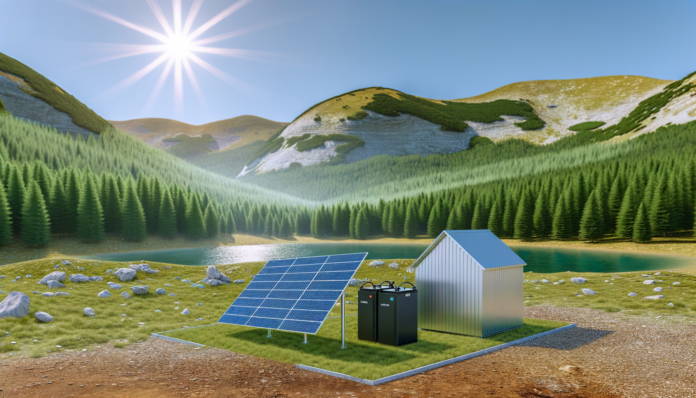Introduction to Off-Grid Solar Energy
The Rise of Off-Grid Living
In recent years, there has been a significant shift towards off-grid living, driven by a combination of environmental concerns, technological advancements, and a desire for energy independence. Off-grid living refers to a lifestyle where individuals or communities are not connected to the public electricity grid. Instead, they rely on alternative energy sources, such as solar power, to meet their energy needs. This movement has gained momentum as people seek to reduce their carbon footprint, lower energy costs, and achieve greater self-sufficiency.
Importance of Solar Energy in Off-Grid Solutions
Solar energy has emerged as a cornerstone of off-grid solutions due to its numerous advantages. Firstly, solar power is a renewable and abundant energy source, making it an environmentally friendly option. Unlike fossil fuels, solar energy does not produce greenhouse gases or other pollutants, contributing to a cleaner and healthier environment. Additionally, solar energy systems can be installed in remote locations, providing electricity to areas that are not served by the traditional grid. This is particularly beneficial for rural communities, emergency situations, and outdoor enthusiasts.
Moreover, solar energy systems have become more affordable and efficient over the years, making them a viable option for off-grid living. The cost of solar panels has decreased significantly, and advancements in technology have improved their efficiency and durability. As a result, more people are turning to solar energy as a reliable and cost-effective solution for their off-grid energy needs.
Overview of Solar Technology Advancements
The evolution of solar technology has been remarkable, with continuous innovations driving the industry forward. One of the most significant advancements is the increase in solar panel efficiency. In the early days, solar panels had a conversion efficiency of around 10%, meaning they could only convert a small fraction of the sunlight they captured into usable electricity. However, modern solar panels now achieve conversion efficiencies exceeding 20%, and some even surpass 25%. This means that today’s solar photovoltaic (PV) systems can generate more electricity from the same amount of sunlight, making them more effective and space-efficient.
Another notable advancement is the development of new materials, such as perovskite solar cells. These materials offer high efficiency and low production costs, positioning them as potential game-changers in the renewable energy industry. Perovskite-silicon tandem solar cells, for example, combine the strengths of both materials to achieve even higher performance.
Additionally, bifacial solar panels have gained popularity due to their ability to capture sunlight from both sides, increasing energy yield. Flexible and lightweight solar panels have also emerged, allowing for versatile applications, including integration into clothing, vehicles, and portable devices.
Energy storage technology has also seen significant improvements, with advanced batteries such as lithium-ion and flow batteries offering higher energy density, longer lifespan, and better performance. These advancements in energy storage are crucial for off-grid systems, as they enable the storage of excess solar energy for use during periods of low sunlight or at night.
In conclusion, the rise of off-grid living, the importance of solar energy in off-grid solutions, and the continuous advancements in solar technology are shaping the future of off-grid energy. As solar technology continues to evolve, it promises to provide more efficient, cost-effective, and sustainable energy solutions for those seeking to live independently from the traditional grid.
Core Technologies in Off-Grid Solar Systems
Photovoltaic (PV) Panels
Photovoltaic (PV) panels are the cornerstone of any off-grid solar system. These panels convert sunlight directly into electricity through the photovoltaic effect, a process discovered by French physicist Edmond Becquerel in 1839. Modern PV panels are typically made from silicon and can achieve efficiencies of over 20%, making them highly effective for generating electricity in various conditions. The advancements in PV technology, such as the development of multi-junction cells and the use of perovskite materials, have significantly increased their efficiency and reduced costs, making solar power more accessible and practical for off-grid applications.
Solar Batteries and Energy Storage
One of the main challenges of solar energy is its intermittent nature; it only generates power when the sun is shining. This is where solar batteries and energy storage systems come into play. These systems store excess energy produced during the day for use at night or during cloudy periods. Lithium-ion batteries, particularly lithium iron phosphate (LFP) batteries, are currently the most popular choice due to their high energy density, long lifespan, and safety features. The integration of energy storage systems with PV panels ensures a reliable and continuous power supply, making off-grid living more feasible and convenient.
Charge Controllers
Charge controllers are essential components in off-grid solar systems, responsible for regulating the voltage and current coming from the PV panels to the batteries. They prevent overcharging and over-discharging, which can significantly reduce the lifespan of the batteries. There are two main types of charge controllers: Pulse Width Modulation (PWM) and Maximum Power Point Tracking (MPPT). MPPT controllers are more efficient as they continuously adjust the electrical operating point of the modules, ensuring maximum power output. This efficiency is crucial for optimizing the performance of off-grid solar systems.
Inverters
Inverters play a critical role in converting the direct current (DC) generated by PV panels and stored in batteries into alternating current (AC), which is the standard form of electricity used in homes and businesses. There are different types of inverters, including pure sine wave, modified sine wave, and microinverters. Pure sine wave inverters are the most efficient and reliable, providing clean power that is compatible with all types of electrical appliances. The evolution of inverters has seen significant advancements, such as the integration of smart technologies and improved efficiency, making them indispensable for modern off-grid solar systems.
In summary, the core technologies of off-grid solar systems—PV panels, solar batteries, charge controllers, and inverters—work in harmony to provide a reliable and sustainable energy solution. Continuous advancements in these technologies are making off-grid living more practical and appealing, paving the way for a future where energy independence and sustainability are within reach for everyone.
Innovative Solar Solutions for Off-Grid Living
Portable Solar Panels
Portable solar panels have revolutionized the way we think about off-grid energy solutions. These lightweight, foldable panels are designed for easy transport and quick setup, making them ideal for camping, emergency situations, and remote work sites. Companies like Goal Zero and Jackery offer a range of portable solar products that can power small devices, lights, and even small appliances. The convenience and flexibility of portable solar panels make them a popular choice for those seeking a reliable and renewable energy source on the go.
Solar Generators
Solar generators are another innovative solution for off-grid living. Unlike traditional gas-powered generators, solar generators harness energy from the sun, store it in built-in batteries, and provide a clean, quiet, and renewable power source. These generators are perfect for backup power during outages, outdoor activities, and even for use in tiny homes or RVs. Brands like EcoFlow and Bluetti have developed advanced solar generators that offer high capacity, multiple output options, and fast recharging times, making them a versatile and eco-friendly alternative to conventional generators.
Solar-Powered Appliances
The advent of solar-powered appliances has significantly enhanced the feasibility of off-grid living. These appliances are designed to operate efficiently on solar power, reducing the need for traditional electricity sources. Examples include solar refrigerators, solar ovens, and solar-powered fans. Solar refrigerators, for instance, are crucial for preserving food and medicines in remote areas where electricity is unreliable. Companies like Fenice Energy and Koolboks are leading the way in providing solar-powered refrigeration solutions that are both efficient and sustainable.
Solar Water Heaters
Solar water heaters are an excellent example of how solar technology can be integrated into everyday household needs. These systems use solar panels to collect and convert sunlight into heat, which is then used to warm water for domestic use. Solar water heaters are particularly beneficial in off-grid settings, where traditional water heating methods may be impractical or costly. They offer a sustainable and cost-effective way to ensure a steady supply of hot water, reducing reliance on fossil fuels and lowering energy bills. Systems like those from Rheem and Sunbank are designed to be durable and efficient, making them a valuable addition to any off-grid home.
In summary, the innovations in portable solar panels, solar generators, solar-powered appliances, and solar water heaters are making off-grid living more practical and sustainable. These technologies not only provide reliable energy solutions but also contribute to reducing carbon footprints and promoting energy independence. As advancements continue, the future of off-grid solar energy looks increasingly promising.
Emerging Technologies and Trends
Flexible and Thin-Film Solar Panels
Flexible and thin-film solar panels represent a significant leap in solar technology, offering versatility and adaptability that traditional rigid panels cannot match. These panels are made using materials like amorphous silicon, cadmium telluride, or copper indium gallium selenide (CIGS), which allow them to be lightweight and flexible. This flexibility enables their integration into a variety of surfaces, including curved and irregular shapes, making them ideal for applications in portable devices, vehicles, and even clothing.
One of the most exciting developments in this area is the creation of ultralight fabric solar cells by researchers at MIT. These cells are thinner than a human hair and can be easily affixed to any surface, producing 18 times more power per kilogram than traditional solar panels. The potential applications for these flexible panels are vast, ranging from powering remote sensors to integrating into building materials for seamless energy generation.
Bifacial Solar Panels
Bifacial solar panels are an innovative advancement that allows for the capture of sunlight on both sides of the panel. Unlike traditional monofacial panels, which only absorb light from the front, bifacial panels can harness reflected sunlight from surfaces such as the ground, water, or nearby structures. This dual-sided design can increase energy production by up to 30%, making them particularly effective in environments with high albedo, such as snowy or sandy areas.
The National Renewable Energy Laboratory (NREL) is currently exploring the development of bifacial perovskite solar cells, which could further enhance the efficiency and potential of this technology. Despite their higher initial cost and the need for specialized mounting systems, the increased energy yield and durability of bifacial panels make them a promising option for large-scale solar projects and commercial installations.
Solar Tracking Systems
Solar tracking systems are designed to optimize the orientation of solar panels throughout the day to follow the sun’s path, thereby maximizing sunlight capture and energy production. There are two main types of solar trackers: single-axis and dual-axis. Single-axis trackers move panels along one axis, typically north to south, while dual-axis trackers adjust panels along both horizontal and vertical axes for optimal positioning.
These systems can increase energy production by 10-25% compared to fixed-tilt systems. Advances in tracking technology and materials are making these systems more affordable and reliable, enhancing their adoption in large solar farms and commercial installations. The integration of solar tracking systems with smart technologies and IoT can further optimize their performance, allowing for real-time adjustments based on weather conditions and energy demand.
Integration with Smart Home Technologies
The integration of solar energy systems with smart home technologies is revolutionizing the way we manage and optimize energy use. Smart solar solutions leverage the Internet of Things (IoT) to enable remote monitoring and control of solar installations. This allows homeowners to track energy production, consumption, and storage in real-time, making it easier to manage energy use efficiently.
Smart inverters play a crucial role in this integration, converting the direct current (DC) electricity produced by solar panels into usable alternating current (AC) electricity while optimizing the flow of energy between the solar panels, battery storage, and the grid. These inverters can also provide valuable grid services, such as voltage regulation and frequency control, enhancing the overall stability and reliability of the power grid.
Moreover, the use of AI and machine learning in smart solar systems can predict energy production and consumption patterns, enabling proactive maintenance and optimization. This not only improves the efficiency and lifespan of solar installations but also contributes to a more resilient and sustainable energy infrastructure.
Environmental and Economic Benefits
Reducing Carbon Footprint
One of the most significant environmental benefits of off-grid solar energy systems is their ability to reduce carbon footprints. Traditional energy sources, such as coal and natural gas, emit large amounts of carbon dioxide (CO2) and other greenhouse gases, contributing to global warming and climate change. In contrast, solar energy is a clean, renewable resource that generates electricity without emitting harmful pollutants. By harnessing the power of the sun, off-grid solar systems help to mitigate the adverse effects of fossil fuel consumption, promoting a healthier and more sustainable environment.
Cost Savings Over Time
While the initial investment in off-grid solar systems can be substantial, the long-term economic benefits are considerable. Solar energy systems have low operational and maintenance costs compared to conventional energy sources. Once installed, solar panels generate electricity at no additional cost, leading to significant savings on energy bills. Additionally, advancements in solar technology have driven down the cost of solar panels and related components, making solar energy more affordable and accessible. Over time, the savings on energy expenses can offset the initial investment, providing a high return on investment (ROI) for homeowners and businesses alike.
Energy Independence
Off-grid solar energy systems offer a pathway to energy independence, reducing reliance on centralized power grids and fossil fuels. This independence is particularly beneficial in remote or rural areas where access to the grid is limited or non-existent. By generating their own electricity, individuals and communities can ensure a reliable and uninterrupted power supply, even during grid outages or natural disasters. Energy independence also shields consumers from fluctuating energy prices and geopolitical tensions that can impact the availability and cost of fossil fuels.
Supporting Sustainable Living
Adopting off-grid solar energy systems aligns with the principles of sustainable living, which emphasize reducing environmental impact and conserving natural resources. Solar energy is abundant and inexhaustible, making it a sustainable alternative to finite fossil fuels. By integrating solar power into their daily lives, individuals and communities can reduce their ecological footprint and contribute to a more sustainable future. Moreover, the use of solar energy supports the development of green technologies and industries, fostering economic growth and job creation in the renewable energy sector.
In conclusion, the environmental and economic benefits of off-grid solar energy systems are profound. From reducing carbon emissions and achieving cost savings to promoting energy independence and supporting sustainable living, solar energy is a powerful tool in the transition towards a cleaner, more resilient, and sustainable energy future.
Challenges and Considerations
Initial Investment Costs
One of the most significant barriers to adopting off-grid solar energy systems is the initial investment cost. Setting up a comprehensive off-grid solar system involves purchasing photovoltaic (PV) panels, batteries for energy storage, charge controllers, and inverters. Additionally, there are costs associated with installation, which may require professional expertise. While the long-term savings and environmental benefits are substantial, the upfront financial commitment can be daunting for many individuals and businesses. **Government incentives and subsidies** can help mitigate these costs, but they are not always available or sufficient to cover the entire expense.
Maintenance and Durability
Maintaining an off-grid solar system is crucial to ensure its longevity and efficiency. **Solar panels** generally require minimal maintenance, primarily periodic cleaning to remove dust and debris that can reduce their efficiency. However, other components like batteries and inverters may need more attention. Batteries, in particular, have a limited lifespan and will need to be replaced every few years, depending on the type and usage. Ensuring the durability of these systems in various environmental conditions is also a concern. Regular inspections and timely maintenance can help in identifying and addressing potential issues before they escalate, but this adds to the overall cost and effort required to maintain the system.
Weather and Climate Impact
The performance of off-grid solar systems is heavily influenced by weather and climate conditions. **Solar panels** are most effective in regions with abundant sunlight. In areas with frequent cloud cover, rain, or snow, the efficiency of solar energy generation can be significantly reduced. Seasonal variations also play a role; for instance, shorter days in winter mean less sunlight and, consequently, less energy production. To mitigate these impacts, systems often need to be oversized or supplemented with alternative energy sources, such as wind or diesel generators, which can increase the complexity and cost of the system.
Technological Limitations
Despite significant advancements, there are still technological limitations that affect the efficiency and reliability of off-grid solar systems. **Energy storage technology**, particularly batteries, is one of the critical areas where limitations are evident. Current battery technologies, such as lithium-ion, have limitations in terms of capacity, lifespan, and cost. Additionally, the efficiency of solar panels, while improved, is still not optimal, with most commercial panels converting only about 20-25% of sunlight into usable electricity. Innovations like **perovskite solar cells** and **bifacial panels** show promise but are not yet widely available or affordable. Furthermore, integrating these systems with smart home technologies and ensuring seamless operation can be challenging, requiring sophisticated software and hardware solutions.
In conclusion, while off-grid solar energy systems offer numerous benefits, including energy independence and environmental sustainability, several challenges and considerations must be addressed. Initial investment costs, maintenance requirements, weather and climate impacts, and technological limitations are significant factors that potential adopters need to consider. Overcoming these challenges will require continued innovation, supportive policies, and a commitment to sustainable practices.
Future Outlook and Conclusion
Predictions for Solar Technology Advancements
The future of solar technology is brimming with potential, driven by continuous innovation and decreasing costs. One of the most promising advancements is the development of **perovskite solar cells**, which offer higher efficiency at a lower cost compared to traditional silicon cells. These cells have already achieved efficiency rates exceeding 25% in laboratory settings and are expected to become commercially viable soon.
Another exciting development is the rise of **multi-junction solar cells**, which can capture a broader spectrum of sunlight by using multiple layers of different semiconductor materials. These cells have achieved efficiencies of over 40% in laboratory conditions, making them particularly attractive for high-demand applications like space missions.
**Tandem solar cells**, which combine different types of solar cells to maximize efficiency, are also gaining traction. Recent advancements have seen these cells achieve efficiencies exceeding 30%, and ongoing research aims to push these numbers even higher.
In addition to efficiency improvements, **innovations in solar panel design** are making solar energy more accessible and versatile. **Bifacial solar panels** that capture sunlight on both sides and **flexible, lightweight panels** are expanding the range of applications for solar technology. These advancements are expected to make solar energy more integrated into everyday life, from building materials to portable devices.
The Role of Policy and Incentives
Government policies and incentives play a crucial role in the adoption and growth of solar energy. Financial incentives such as tax credits, grants, and feed-in tariffs can significantly reduce the upfront costs of solar installations, making them more attractive to consumers and businesses. For instance, the **Investment Tax Credit (ITC)** in the United States has been instrumental in driving the adoption of solar energy by providing a substantial tax credit for solar system installations.
**Renewable energy targets** set by governments around the world are also driving the growth of solar energy. Countries like Germany, China, and India have set ambitious goals for renewable energy adoption, which include substantial contributions from solar power. These targets not only encourage the deployment of solar systems but also stimulate innovation and investment in solar technology.
**Net metering policies** allow solar panel owners to sell excess electricity back to the grid, providing financial benefits and encouraging more people to adopt solar energy. These policies vary by region but have a significant impact on the economics of solar energy, making it a more viable option for many.
Moreover, **corporate sustainability initiatives** are increasingly driving the adoption of solar energy. Many companies are committing to renewable energy targets and investing in solar installations to reduce their carbon footprints and enhance their brand image. This corporate demand is further accelerating the growth and innovation in the solar industry.
Final Thoughts on Off-Grid Solar Energy
The future of off-grid solar energy is incredibly promising, offering a sustainable and reliable solution for energy independence. As technology continues to advance, the efficiency and affordability of solar systems will improve, making them accessible to a broader range of consumers. Innovations in energy storage and smart grid integration will further enhance the reliability and effectiveness of off-grid solar systems.
The environmental and economic benefits of off-grid solar energy are substantial. By reducing reliance on fossil fuels, off-grid solar systems contribute to a significant reduction in carbon emissions, supporting global efforts to combat climate change. Additionally, the long-term cost savings and energy independence offered by solar systems make them an attractive investment for both individuals and businesses.
However, challenges such as initial investment costs, maintenance, and technological limitations need to be addressed to fully realize the potential of off-grid solar energy. Supportive policies and incentives, along with continued innovation, will be crucial in overcoming these challenges.
In conclusion, the future of off-grid solar energy is bright, with continuous advancements in technology and supportive policies driving its growth. By harnessing the power of the sun, we can create a more sustainable, resilient, and equitable energy future for all.






